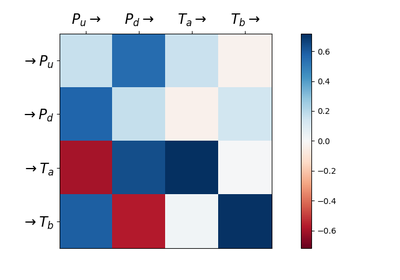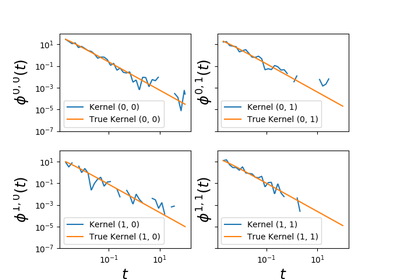tick.hawkes.HawkesConditionalLaw¶
-
class
tick.hawkes.HawkesConditionalLaw(delta_lag=0.1, min_lag=0.0001, max_lag=40, n_quad=50, max_support=40, min_support=0.0001, quad_method='gauss', marked_components=None, delayed_component=None, delay=1e-05, model=None, n_threads=1, claw_method='lin')[source]¶ This class is used for performing non parametric estimation of multi-dimensional marked Hawkes processes based on conditional laws.
Marked Hawkes processes are point processes defined by the intensity:
\[\forall i \in [1 \dots D], \quad \lambda_i = \mu_i + \sum_{j=1}^D \int \phi_{ij} * f_{ij}(v_j) dN_j\]where
\(D\) is the number of nodes
\(\mu_i\) are the baseline intensities
\(\phi_{ij}\) are the kernels
\(v_j\) are the marks (considered iid) of the process \(N_j\)
\(f_{ij}\) the mark functions supposed to be piece-wise constant on intervals \(I^j(l)\)
The estimation is made from empirical computations of
\[\lim_{\epsilon \rightarrow 0} E [ (N_i[t + lag + \delta + \epsilon] - \Lambda[t + lag + \epsilon]) | N_j[t]=1 \quad \& \quad v_j(t) \in I^j(l) ]\]For all the possible values of \(i\), \(i\) and \(l\). The \(lag\) is sampled on a uniform grid defined by \(\delta\): \(lag = n * \delta\).
Estimation can be performed using several realizations.
- Parameters
claw_method : {‘lin’, ‘log’}, default=’lin’
Specifies the way the conditional laws are sampled. It can be either:
‘lin’ : sampling is linear on [0, max_lag] using sampling period delta_lag
‘log’ : sampling is semi-log. It uses linear sampling on [0, min_lag] with sampling period delta_lag and log sampling on [min_lag, max_lag] using \(\exp(\delta)\) sampling period.
delta_lag :
float, default=0.1See claw_methods
min_lag :
float, default=1e-4See claw_methods
max_lag :
float, default=40See claw_methods
quad_method : {‘gauss’, ‘lin’, ‘log’}, default=gauss
Sampling used for quadrature
‘gauss’ for gaussian quadrature
‘lin’ for linear quadrature
‘log’ for log quadrature
min_support :
float, default=1e-4Start value of kernel estimation. It is used for ‘log’ quadrature method only, otherwise it is set to 0.
max_support :
float, default=40End value of kernel estimation
n_quad :
intThe number of quadrature points between [min_support, max_support] used for solving the system. Be aware that the complexity increase as this number squared.
n_threads :
int, default=1Number of threads used for parallel computation.
if
int <= 0: the number of physical cores available on the CPUotherwise the desired number of threads
- Attributes
n_nodes :
intNumber of nodes of the estimated Hawkes process
n_realizations :
intNumber of given realizations
baseline : np.ndarray, shape=(n_nodes,)
Estimation of the baseline
kernels_norms : np.ndarray, shape=(n_nodes, n_nodes)
L1 norm matrix of the kernel norms
kernels : list of list
Kernel’s estimation on the quadrature points
mean_intensity : list of
floatThe estimated mean intensity
symmetries1d : list of 2-tuple
List of component index pairs for imposing symmetries on the mean intensity (e.g,
[(0,1),(2,3)]means that the mean intensity of the components 0 and 1 must be the same and the mean intensity of the components 2 and 3 also Can be set using can be set using theset_modelmethod.symmetries2d : list of 2-tuple of 2-tuple
List of kernel coordinates pairs to impose symmetries on the kernel matrix (e.g.,
[[(0,0),(1,1)],[(1,0),(0,1)]]for a bidiagonal kernel in dimension 2) Can be set using can be set using theset_modelmethod.mark_functions : list of 2-tuple
The mark functions as a list (lexical order on i,j and l, see below)
References
Bacry, E., & Muzy, J. F. (2014). Second order statistics characterization of Hawkes processes and non-parametric estimation. arXiv preprint arXiv:1401.0903.
-
__init__(delta_lag=0.1, min_lag=0.0001, max_lag=40, n_quad=50, max_support=40, min_support=0.0001, quad_method='gauss', marked_components=None, delayed_component=None, delay=1e-05, model=None, n_threads=1, claw_method='lin')[source]¶ Initialize self. See help(type(self)) for accurate signature.
-
fit(events: list, T=None)[source]¶ Fit the model according to the given training data.
- Parameters
events :
listoflistofnp.ndarrayList of Hawkes processes realizations. Each realization of the Hawkes process is a list of n_node for each component of the Hawkes. Namely
events[i][j]contains a one-dimensionalnumpy.arrayof the events’ timestamps of component j of realization i. If only one realization is given, it will be wrapped into a listT :
double, default=NoneThe duration (in physical time) of the realization. If it is None then T is considered to be the time of the last event (of any component).
- Returns
output :
HawkesConditionalLawThe current instance of the Learner
-
get_kernel_norms()[source]¶ Computes kernel norms. This makes our learner compliant with
tick.plot.plot_hawkes_kernel_normsAPI- Returns
norms :
np.ndarray, shape=(n_nodes, n_nodes)2d array in which each entry i, j corresponds to the norm of kernel i, j
-
get_kernel_supports()[source]¶ Computes kernel support. This makes our learner compliant with
tick.plot.plot_hawkes_kernelsAPI- Returns
output :
np.ndarray, shape=(n_nodes, n_nodes)2d array in which each entry i, j corresponds to the support of kernel i, j
-
get_kernel_values(i, j, abscissa_array)[source]¶ Computes value of the specified kernel on given time values. This makes our learner compliant with
tick.plot.plot_hawkes_kernelsAPI- Parameters
i :
intFirst index of the kernel
j :
intSecond index of the kernel
abscissa_array :
np.ndarray, shape=(n_points, )1d array containing all the times at which this kernel will computes it value
- Returns
output :
np.ndarray, shape=(n_points, )1d array containing the values of the specified kernels at the given times.
-
incremental_fit(realization, T=None, compute=True)[source]¶ Allows to add some more realizations before estimation is performed.
It updates the conditional laws (stored in
self._clawandself._claw1) and of the mean intensity (inself._mean_intensity).- Parameters
realization : list of
np.narraysor list of 2-tuple ofnp.arrayslist of
np.narrays, shape=(N) , representing the arrival times of each componentlist of pairs (t,m) np.arrays representing the arrival times of each component (x) and the cumulative marks signal (m)
T :
double, default=NoneThe duration (in physical time) of the realization. If it is -1 then T is considered to be the time of the last event (of any component).
compute :
bool, default=`False`Computes kernel estimation. If set to
False, you will have to manually callcomputemethod afterwards. This is useful to add multiple realizations and compute only once all conditional laws have been updated.
-
set_model(symmetries1d=[], symmetries2d=[], delayed_component=None)[source]¶ Set the model to be used.
- Parameters
symmetries1d : list of 2-tuple
List of component index pairs for imposing symmetries on the mean intensity (e.g,
[(0,1),(2,3)]means that the mean intensity of the components 0 and 1 must be the same and the mean intensity of the components 2 and 3 also. Can be set using can be set using theset_modelmethod.symmetries2d : list of 2-tuple of 2-tuple
List of kernel coordinates pairs to impose symmetries on the kernel matrix (e.g.,
[[(0,0),(1,1)],[(1,0),(0,1)]]for a bidiagonal kernel in dimension 2) Can be set using can be set using theset_modelmethod.delayed_component : list of
int, shape=(N, ), default=`None`list of node indices corresponding to node that should be delayed (to avoid simultaneous jumps of different components which can be a problem in the estimation)
If no model is specified then default values for these fields are used :
Notes
We set the symmetries, the kernel names and delayed components for first realization only

